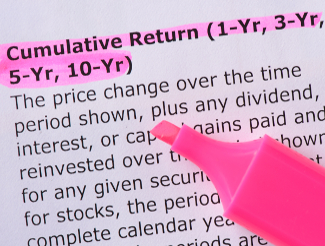While most investors know that past performance is no predictor of future performance, they nonetheless look at past performance as a potential indicator of the future. Particularly when you’re looking at mutual funds or index funds, judging fund managers on their ability to pick the right assets for a fund can be a very important part of doing your homework. But if you’re relying just on the numbers provided in fund prospectuses you could find yourself missing out on a whole lot of important information. That’s why it’s vitally important as an investor to look behind the numbers and crunch some of your own data in order to get a really good idea of whether or not an investment makes sense to you.
Available Information May Be Incomplete
When you take your first initial look at most funds, you’ll see mostly short- and mid-term performance figures. Those are the returns for the year to date, for the past year, the past five years, and the past 10 years. Most prospectuses will also have figures for the performance of the fund since its beginning, which depending on the age of the fund may or may not be very helpful. But none of these numbers may be very helpful to many investors, particularly those who are worried about how a particular investment will fare during a market downturn.
So many investors get caught up in achieving massive upside growth that they forget that it’s just as important to minimize losses during a market crash, recession, or financial crisis. You can find information on how various funds performed during a particular calendar year, but rarely can you find how they performed from peak to trough of a recession or market crash.
Even worse, the headline data that you see on 1-year, 5-year, and 10-year performance often masks how poorly some of these funds performed during crises. We’re 10 years out now from the beginning of the worst part of the financial crisis, with stocks starting to really tank in September and October 2008 before bottoming out in March 2009. The 10-year growth rates from those bottoms will look pretty darn good in investment prospectuses over the next few months, obscuring the fact that those funds may not have performed very well throughout the crisis.
So if you’re an investor looking to invest in any sort of asset, look at how that asset performed from the market peak in October 2007 to the market trough in March 2009. Overall stock market indexes cratered during that period, with the Dow Jones Industrial Average down 54%, the NASDAQ down 55%, and the S&P 500 down 57%. If you’re looking at funds or assets that performed worse than that during the financial crisis, you may want to take a harder and closer look to see whether those assets will perform just as badly during the next crisis.
Conventional Assets Versus Gold
By contrast, gold’s performance during that time frame is relatively easy to assess thanks to publicly available price information. Gold closed in New York at $736.70 on October 9, 2007, and at $921.50 on March 9, 2009. That’s a 25% increase at a time when financial pundits and even government officials were afraid that the entire financial system would come crashing down.
But gold didn’t just stop there, it continued to grow, more than doubling in price over the next couple of years as financial conditions remained unsettled. And while gold’s price has decreased since then, it is poised once again to make another run once the next financial crisis occurs. In fact, if you had invested 30% of your portfolio into gold before the financial crisis, not only would your portfolio have lost less money during the crisis, it would have continued to outperform a 100% equity portfolio for the next several years, up until this summer’s stock market highs.
Gold has been a trusted asset for centuries, as investors flock to it during times of political turmoil and financial upheaval. And with modern developments such as gold IRAs, you can invest in gold just as easily as you would invest in conventional financial assets. You can even roll over existing 401(k), IRA, and TSP retirement assets into a gold IRA tax-free. So if you find yourself worrying about the value of your retirement assets and wanting to ensure that everything you’ve worked so long and hard to accumulate remains safe, look to the stability and security that only gold can offer.
This article was originally posted on Goldco.





